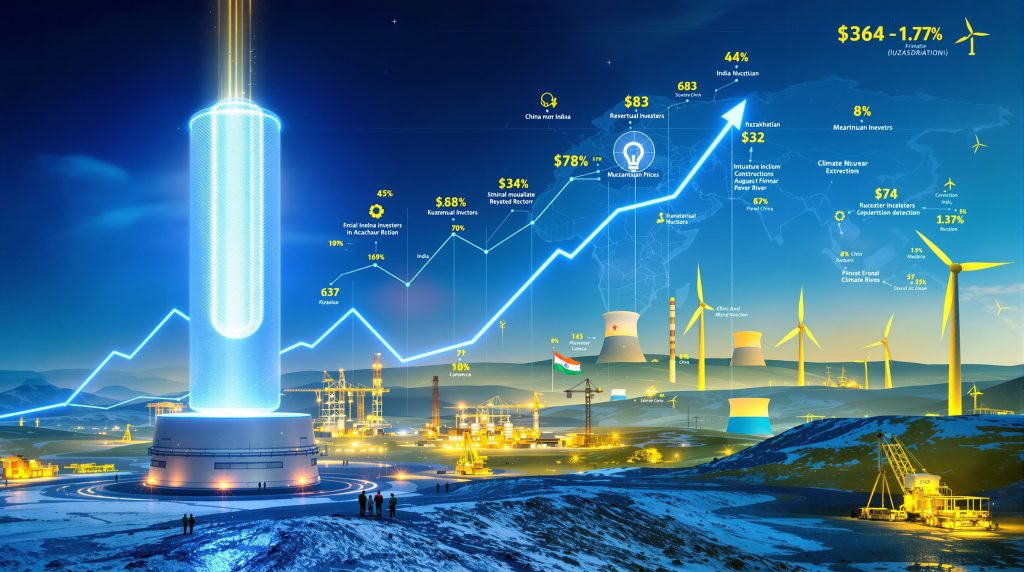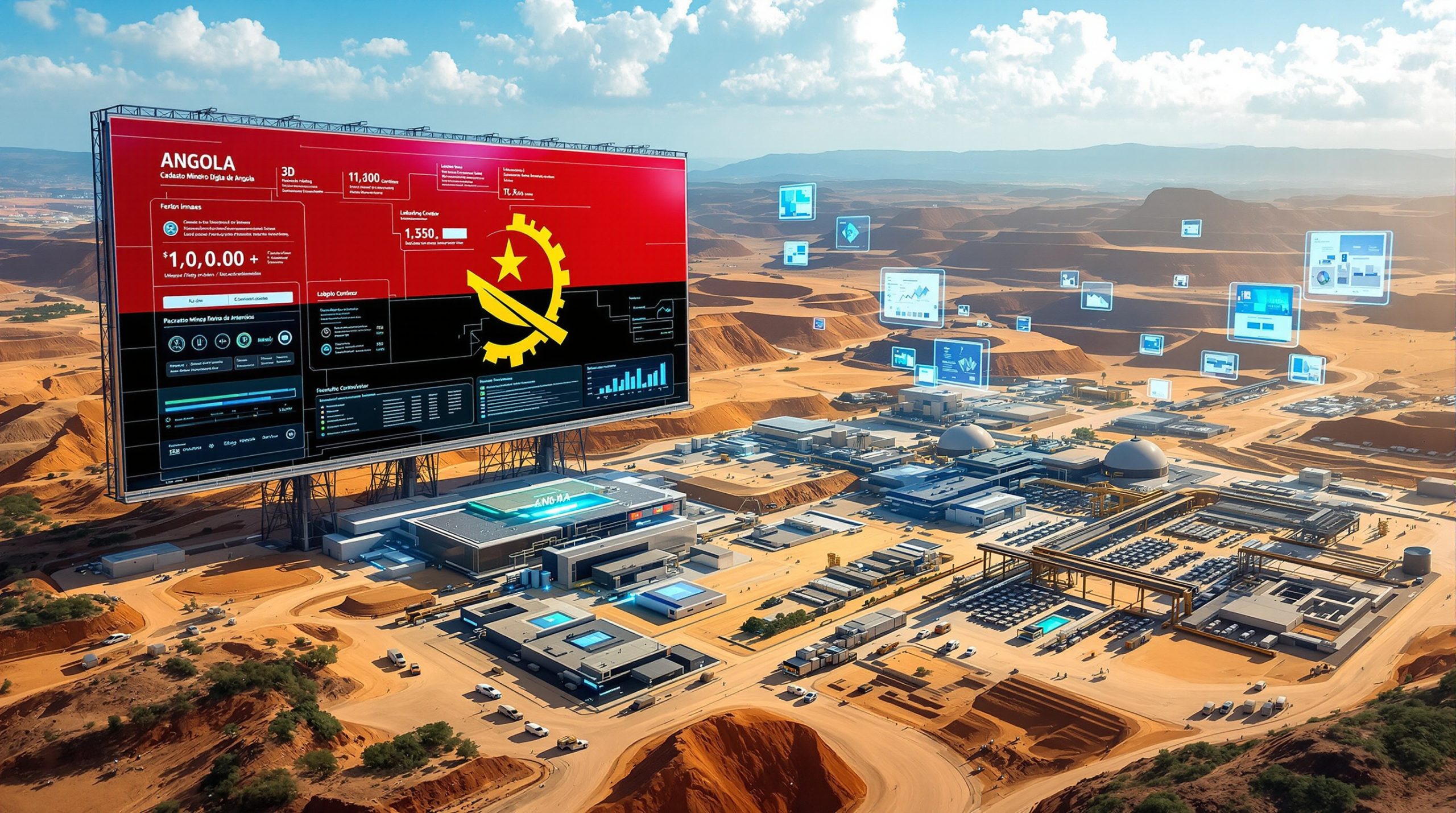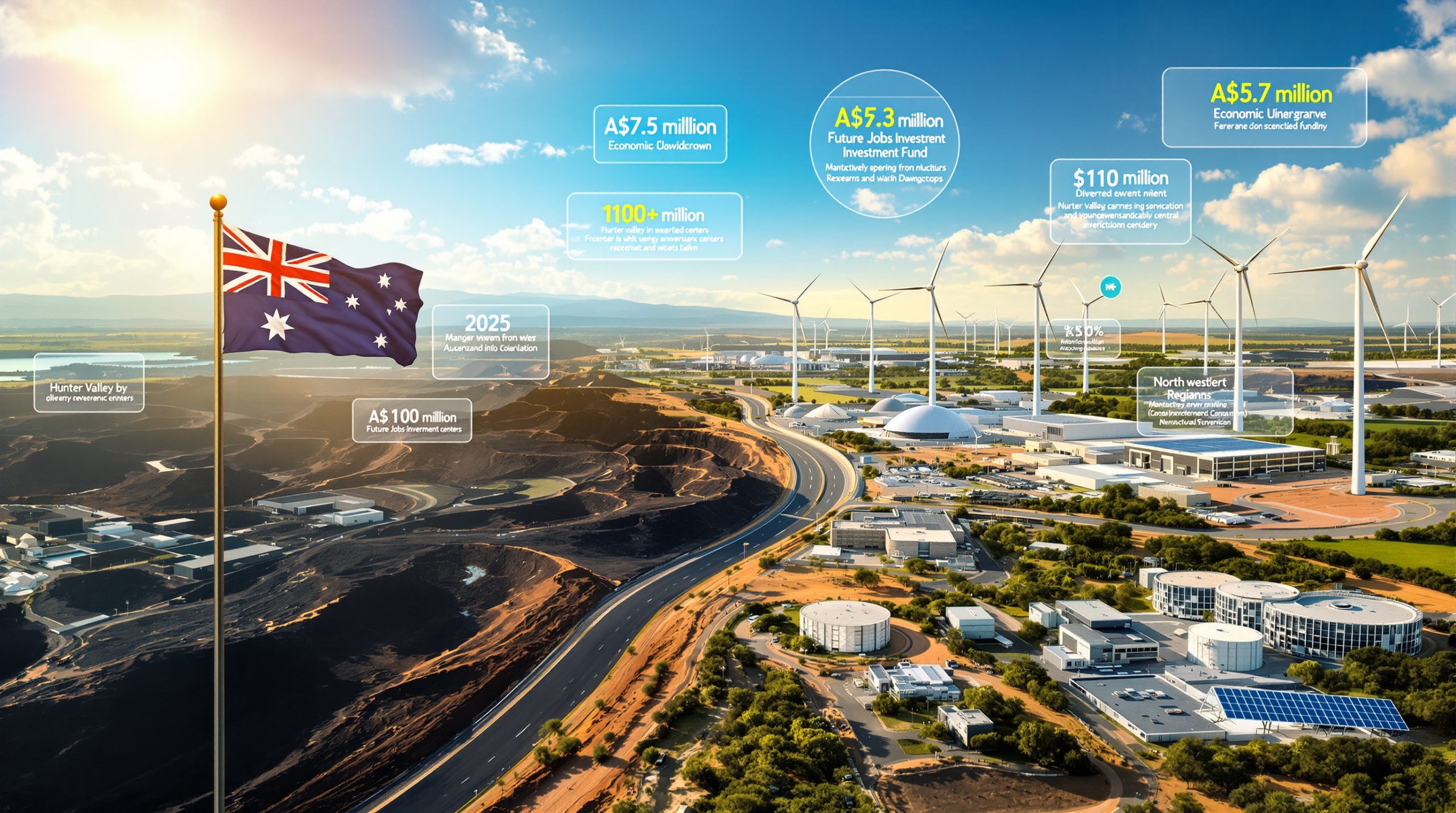What's Driving the Current Uranium Price Rally?
The uranium market is experiencing a significant price surge in 2025, with spot prices reaching levels not seen in years. As of September 2025, uranium spot prices hit $82.63 per pound, marking the highest point of the year and demonstrating strong market momentum despite earlier fluctuations.
The rally represents a substantial recovery from the March 2025 low of $64.23 per pound, showing nearly 29% growth within six months. This upward trajectory has continued steadily, surpassing the previous high of $78.50 recorded in June 2025, reflecting growing confidence in the uranium sector's fundamentals.
Record-Breaking 2025 Price Movements
The uranium market has shown remarkable resilience throughout 2025, with several key price milestones:
- End of September 2025 spot price: $82.63 per pound (year's highest mark)
- Previous 2025 low: $64.23 per pound (March 2025)
- Previous 2025 high: $78.50 per pound (June 2025)
- September 2025 long-term price: $83.00 per pound
- Uranium futures as of October 2, 2025: $83.10 per pound
Market analysts note that current prices are only marginally lower than the near-one-year high of $83.50 touched on September 25th, suggesting continued strength in the market despite some profit-taking from short-term traders.
Supply Constraints Creating Market Pressure
The current uranium rally is primarily driven by significant supply constraints affecting major global producers. These limitations have created a fundamental imbalance in the market that price increases have yet to fully correct.
Cameco's McArthur River mine in Saskatchewan, one of the world's richest uranium deposits, has faced notable challenges. The company has announced a 19% forecasted drop in mined output from this key facility due to expansion delays, significantly impacting global supply projections. As one of the lowest-cost producers globally, disruptions at this operation have outsized market effects.
Kazakhstan's Kazatomprom, the world's largest uranium producer accounting for approximately 40% of global primary production, has announced plans for a 10% production cut for 2026. This decision has substantial implications for uranium supply-demand dynamics. With typical lead times for new uranium mines ranging from 7-10 years from discovery to production, the sector cannot quickly respond to price signals.
Industry experts point to the historical underinvestment during the previous low-price cycle (2011-2020) as a critical factor constraining current supply. Furthermore, Paladin Uranium Halt in Namibia has further tightened the market. This structural supply challenge is likely to persist in the medium term.
Institutional Buying Supporting Price Momentum
Physical uranium investment funds have emerged as significant market participants, creating sustained buying pressure that amplifies price movements in the relatively thin uranium market.
The Sprott Physical Uranium Trust has continued its substantial market activity, purchasing 2.3 million pounds in Q3 2025 alone. As the world's largest physical uranium fund, its continued accumulation strategy effectively removes material from the spot market, creating persistent upward price pressure.
Similarly, Yellow Cake, a London-listed uranium holding company, recently raised $125 million specifically for uranium purchases. This capital raise demonstrates the growing institutional interest in uranium as both a commodity investment and portfolio diversification tool.
Market analysts emphasize that purchases by physical holding funds commonly trigger rallies in benchmark prices due to the limited daily trading volumes in uranium markets. With relatively few pounds changing hands on any given day, concentrated institutional buying can have an outsized impact on price discovery.
How Have Uranium Prices Performed Throughout 2025?
Uranium has demonstrated a clear upward trend throughout 2025, with each quarter building on previous gains despite occasional volatility. This steady appreciation represents a marked departure from the prolonged bear market that characterized much of the previous decade.
Quarterly Price Analysis and Trends
The uranium market has shown distinct patterns throughout 2025, with each quarter presenting different market dynamics:
| Quarter | Spot Price Range | Long-Term Price | Key Market Events |
|---|---|---|---|
| Q1 2025 | $64.23 – $70.00 | $80.00 | Market bottom, early recovery signals |
| Q2 2025 | $71.10 – $78.50 | $80.00 – $81.00 | Steady climb, production concerns emerge |
| Q3 2025 | $71.90 – $82.63 | $81.00 – $83.00 | Institutional buying accelerates, supply cuts announced |
| Q4 2025* | $83.10+ | $83.00+ | Continued upward momentum expected |
*Q4 data as of October 2, 2025
Q1 2025 represented a period of price discovery and market bottom formation, with spot prices establishing support above $64 per pound. This period saw initial signs of recovery following the production cuts announced in late 2024.
Q2 2025 built on this foundation with a more consistent upward trend, climbing steadily as production concerns began to surface at major facilities. The convergence between spot and long-term prices during this period indicated growing market confidence in sustained higher prices.
Q3 2025 exhibited the strongest performance, with prices breaking through resistance levels as institutional buying accelerated alongside major supply cut announcements. This quarter established new multi-year highs and signaled a potential shift to a higher trading range.
Price Recovery from Historical Context
The current uranium prices up must be understood within the broader historical context of the market's boom-and-bust cycles.
The post-Fukushima price depression (2011-2020) created a decade-long bear market that drove prices to unsustainable levels below the cost of production for many miners. This prolonged downturn led to significant supply destruction as mines were closed, projects shelved, and exploration budgets slashed.
The recovery phase beginning in 2021 represented the market's recognition of the growing supply gap, with prices gradually climbing from lows around $30 per pound. This initial recovery was tentative but established important support levels.
The acceleration in 2024-2025 marks a more fundamental repricing of uranium as the supply-demand imbalance became increasingly apparent to market participants. Current prices relative to production costs provide important context:
- Average global production cost: $40-60 per pound
- Economic threshold for new mine development: $65-75 per pound
- Current prices ($82.63): Supporting mine restarts and expansions
While current prices have crossed the threshold needed to incentivize some new production, industry experts suggest significantly higher sustained prices may be necessary to trigger the full supply response needed to balance the market long-term.
Why Is Nuclear Energy Demand Increasing Globally?
The fundamental driver behind uranium prices up is the growing global demand for nuclear energy. After years of uncertainty following the Fukushima incident, nuclear power is experiencing a resurgence driven by several converging factors.
Energy Security Driving Policy Shifts
Energy security concerns have emerged as a primary catalyst for nuclear power's renaissance, with nations increasingly prioritizing domestic energy production to reduce external dependencies.
Nuclear energy's ability to provide reliable baseload capacity with minimal fuel input requirements makes it strategically valuable for countries seeking to reduce dependence on imported fossil fuels. A single uranium fuel loading can power a reactor for 18-24 months, dramatically reducing the logistical vulnerabilities associated with continuous fuel imports.
Geopolitical tensions have highlighted the vulnerability of traditional energy supply chains, particularly in regions dependent on natural gas imports. European nations, following recent energy security challenges, have accelerated nuclear commitments, with countries including France, Poland, and the Czech Republic announcing significant expansion plans.
The US ban on Russian uranium has further accelerated the need for domestic production. The Asia-Pacific region similarly demonstrates strong commitment to nuclear expansion, with China, India, and South Korea all pursuing ambitious nuclear development programs driven by both energy security and climate considerations.
Nuclear plants provide exceptional long-term operational certainty, typically functioning for 60-80 years with proper maintenance and upgrades. This longevity, combined with the fact that fuel costs represent only about 10-15% of operational expenses (compared to 70-80% for natural gas plants), provides significant insulation from fuel price volatility.
Decarbonization Goals Accelerating Nuclear Adoption
Climate change mitigation efforts have repositioned nuclear power as an essential component of decarbonization strategies globally.
Nuclear power's role in meeting climate targets has been increasingly recognized by international organizations including the International Energy Agency and the Intergovernmental Panel on Climate Change. Its zero direct carbon emissions during operation provide an immediate climate benefit when replacing fossil fuel generation.
The technology's high capacity factor (typically exceeding 90%) compared to intermittent renewables (20-40% for wind, 10-25% for solar) means nuclear plants deliver consistent carbon-free electricity regardless of weather conditions. This reliability characteristic becomes increasingly valuable as grid operators manage higher penetrations of variable renewable resources.
Nuclear energy's small land footprint relative to energy produced—approximately 0.5-1 square kilometer per gigawatt of capacity compared to 50-150 square kilometers for solar or wind—reduces environmental impacts and land-use conflicts associated with large-scale renewable deployments.
Policy support for the clean energy transition has increasingly incorporated nuclear power through various mechanisms:
- Carbon pricing mechanisms that recognize nuclear's zero-emission profile
- Clean energy standards including nuclear in many jurisdictions
- Financial incentives for maintaining existing nuclear fleet through zero-emission credits
Small Modular Reactors Creating New Market Segments
The development of Small Modular Reactors (SMRs) and advanced reactor technologies is expanding nuclear energy's potential applications and market reach.
These emerging technologies feature smaller footprints enabling deployment in more locations, including those previously unsuitable for conventional large reactors. Their standardized, modular construction methods promise lower capital costs and faster deployment timelines, potentially addressing historical challenges with nuclear project economics.
SMRs' flexible output capabilities complement renewable integration, with many designs specifically engineered to load-follow or provide grid stabilization services alongside variable renewable generation. This flexibility represents a significant departure from conventional nuclear plants primarily designed for baseload operation.
Beyond electricity generation, advanced nuclear technologies are creating opportunities for industrial applications including:
- Process heat for manufacturing (cement, chemicals, steel)
- Hydrogen production through high-temperature electrolysis
- Desalination and district heating applications for urban centers
These non-electric applications could substantially expand uranium demand beyond traditional power generation use cases, creating entirely new market segments.
What Are the Long-Term Uranium Demand Projections?
Long-term demand projections for uranium show substantial growth potential, driven by expanding nuclear capacity and evolving fuel requirements. Understanding these projections is critical for assessing the sustainability of current price movements.
World Nuclear Association's 2025 Forecast
The World Nuclear Association (WNA) released comprehensive demand projections in their September 2025 report that signal a fundamental shift in the uranium market's long-term trajectory:
- 28% increase in uranium demand projected by 2030
- Potential doubling of demand by 2040
- Growth from approximately 67,000 metric tons in 2024 to more than 150,000 metric tons annually by 2040
These projections are primarily driven by energy security considerations, as nations seek to reduce dependence on imported fossil fuels while simultaneously meeting decarbonization targets. The accelerating timelines for climate action have further supported nuclear expansion plans globally.
Regional demand growth variations show significant differences in nuclear adoption rates:
- China leads global expansion with 40+ reactors under construction and plans for 150+ additional units by 2050
- India has dramatically accelerated its nuclear program, targeting 22 GW by 2031 and potentially 100+ GW by 2050
- Western nations, while building fewer new reactors, are extending existing fleet operations from initial 40-year licenses to 60 or 80 years
New Reactor Construction Pipeline
The global reactor construction pipeline provides tangible evidence of future uranium demand growth, with substantial capacity additions expected over the coming decades.
Current global reactor construction status includes:
- 60+ reactors actively under construction worldwide (approximately 65 GW of capacity)
- 100+ reactors in advanced planning stages with site selection and financing arranged
- 300+ reactors proposed or under consideration in government planning documents
These construction activities create significant near-term uranium demand through initial core requirements. New reactors typically require three times their normal annual fuel load at startup, creating demand spikes as construction completes. For example, a typical 1 GW reactor requires approximately 750,000 pounds of U3O8 equivalent for its initial core.
Life-of-plant contracting practices within the nuclear industry further support long-term demand stability. Utilities typically secure uranium supply agreements covering 5-10 years of operation, creating a forward purchasing mechanism that reduces available spot material. These contractual commitments provide important price support even during periods of market volatility.
Impact of Higher Enrichment Requirements
Technological advancements in reactor design are creating additional uranium demand drivers through changing enrichment requirements.
The transition to advanced fuels, particularly High-Assay Low-Enriched Uranium (HALEU) with enrichment levels between 5-20% U-235, creates new demand dynamics. These higher enrichment levels support next-generation reactor designs including many SMRs and advanced reactors currently under development.
While higher enrichment levels theoretically improve fuel efficiency, the increased enrichment process itself requires more natural uranium input per kilogram of fuel produced. This effectively increases uranium requirements per MWh generated for these new designs.
Current enrichment capacity constraints present a significant challenge for the nuclear fuel cycle. Limited global capacity for higher assay enrichment creates potential bottlenecks in the supply chain. New facilities require substantial lead time for development and certification, with regulatory approvals for enrichment expansions progressing slowly in most jurisdictions.
How Will the Market Balance Supply and Demand?
The growing supply-demand imbalance raises critical questions about how and when the uranium market will return to equilibrium. This rebalancing process will likely involve multiple supply sources activated at different price thresholds.
Mining Project Pipeline Analysis
The uranium mining sector's response to higher prices will develop across various operational categories, each with different activation timelines and price sensitivities.
Existing operations with expansion potential represent the most immediate supply response. Brownfield expansions at operating mines can often increase production with minimal additional capital expenditure and regulatory approval. Several key operations, including Cigar Lake in Canada and Olympic Dam in Australia, have expansion potential that could be accelerated in the current price environment.
Restart potential at mothballed operations provides another near-term supply source. Mines placed on care and maintenance during the previous price downturn can potentially return to production within 12-24 months, depending on maintenance conditions and regulatory requirements. Key examples include Langer Heinrich in Namibia and several US ISR uranium production operations.
Greenfield development timeline challenges present more significant hurdles for new supply. Permitting delays affecting new projects frequently extend development timelines beyond initial projections. Capital requirements for new mine development typically range from $100-500 million for moderate-sized operations, creating financing hurdles even at current price levels.
The geographic distribution of new supply shows important regional variations:
- Canada and Australia lead Western production with high-grade, economically competitive deposits
- African nations including Namibia and Niger are increasing production capacity from existing operations
- Kazakhstan maintains its dominant market position but faces potential resource quality degradation over time
Secondary Supply Limitations
Secondary uranium supplies have historically played a significant role in meeting market demand, but these sources face increasing limitations.
The declining impact of historical secondary sources has fundamentally changed market dynamics. The US-Russia HEU (Highly Enriched Uranium) Agreement, which converted weapons material to reactor fuel, concluded in 2013, removing approximately 24 million pounds of annual supply. Government inventories in the US, Europe, and elsewhere have been largely depleted through years of commercial sales.
Underfeeding opportunities, which provided significant secondary supply during periods of low uranium prices, are diminishing as enrichment capacity tightens. Underfeeding occurs when enrichment facilities process less uranium but use more separation work units (SWU) to achieve the same enrichment level, effectively creating excess uranium inventory. As enrichment capacity becomes fully utilized, this source of secondary supply diminishes.
Recycling and reprocessing capacity remains limited globally, with only France, Russia, and Japan maintaining large-scale commercial reprocessing facilities. While these operations recover valuable uranium and plutonium from spent fuel, their total contribution remains relatively small compared to primary production. Long lead times for new facilities (typically 10+ years) and significant capital costs ($10+ billion) limit expansion of this supply source.
Price Signals Needed for Supply Response
Different uranium supply sources become economically viable at varying price thresholds, creating a staged supply response as prices increase.
Economic thresholds for different supply sources show significant variation:
- Existing operations: $40-50/lb production cost, primarily covering operating expenses
- Mine restarts: $55-65/lb threshold, covering restart capital and operating costs
- New conventional mines: $65-80/lb required for full economic returns and capital recovery
- Unconventional resources: $80-100+/lb needed for viable extraction from lower-grade or technically challenging deposits
The investment cycle requirements for uranium projects create inherent delays in supply response. The typical 5-10 year development timeline for new projects means current investments won't yield significant production until the late 2020s or early 2030s. Significant capital expenditure needs, typically hundreds of millions of dollars for conventional mines, require sustained investor confidence in long-term pricing above economic thresholds.
What Are the Investment Implications of Rising Uranium Prices?
The uranium prices up rally has significant implications across the nuclear fuel cycle, affecting mining companies, utilities, and investors in distinct ways. Understanding these investment dynamics provides context for market participants navigating this specialized commodity sector.
Mining Sector Response
The uranium mining sector is responding to higher prices with operational adjustments and strategic positioning for sustained market strength.
Production increases at flexible operations have begun, with companies including Paladin Energy and Energy Fuels announcing plans to ramp up output at existing facilities. These incremental production gains typically represent the first response to improved market conditions.
Accelerated development of expansion projects is evident at major producers, with capital allocation shifting toward growth initiatives. Exploration budgets are increasing significantly across the sector, with junior companies raising record funding for uranium exploration in established and emerging districts.
M&A activity in the sector has accelerated, with several notable transactions already completed in 2025:
- Consolidation among junior miners has accelerated, allowing combined entities to achieve development scale
- Major producers have acquired development assets to secure future production pipelines
- Strategic investments from utilities and financial players have provided development capital while securing future offtake
Utility Procurement Strategies
Uranium end-users are adapting their procurement approaches in response to changing market dynamics and supply risk assessments.
A notable shift from spot to long-term contracting is underway, with utilities increasing contract coverage to secure supply in an increasingly competitive market. While spot market purchases provided cost advantages during the previous buyer's market, security of supply has now taken precedence for many utilities.
Longer-term agreements are being negotiated, with typical contract durations extending from 3-5 years to 7-10 years in many cases. Price escalators and floor prices have become common features in new contracts, providing producers with improved economic certainty while potentially limiting utility exposure to extreme price scenarios.
Inventory management practices are evolving, with many utilities pursuing strategic stockpiling beyond regulatory requirements. While most nuclear operators maintain mandatory minimum inventories (typically 12-24 months of consumption), many are now targeting 3-5 years of coverage as a risk mitigation strategy.
Supply source diversification has become a priority, with utilities seeking multiple suppliers across different geopolitical regions to reduce concentration risk. Geographic risk mitigation strategies increasingly favor suppliers in politically stable jurisdictions despite potential price premiums.
Market Sentiment Indicators
Investor sentiment toward uranium has improved dramatically, with several key indicators suggesting growing confidence in the sector's fundamentals.
Speculative positioning in uranium equities shows increasing institutional participation. Key sentiment metrics include:
- Junior miner valuations have increased significantly, with average price-to-book ratios rising from 1.2x to 2.5x over the past year
- Producer forward P/E ratios currently average 12-15x, suggesting confidence in sustained higher prices
- Exploration company funding success has improved markedly, with over $500 million raised for uranium exploration in 2025 to date
Institutional investor participation has broadened beyond specialized uranium funds to include more generalist resources investors and even some ESG-focused funds. This expanding investor base provides additional liquidity and potentially more stable capital for sector development.
ESG considerations in nuclear investments have evolved significantly, with growing recognition of nuclear power's role in climate change mitigation. While legacy environmental concerns remain for some investors, uranium's critical role in low-carbon energy production has improved its acceptance within sustainable investment frameworks.
FAQs About the Uranium Market
The uranium market's specialized nature often raises questions from investors and industry observers. Here are answers to some frequently asked questions about current market dynamics.
How do physical uranium funds impact market prices?
Physical uranium funds like Sprott Physical Uranium Trust purchase and hold uranium, removing it from circulation in the spot market. Given the relatively thin trading volume in uranium markets—typically only a few hundred thousand pounds daily—these purchases can significantly impact available supply.
When multiple funds actively buy simultaneously, as occurred during Q3 2025, their collective impact can drive prices higher through simple supply-demand mechanics. Unlike traditional commodity ETFs that use futures contracts, physical uranium funds actually take delivery of uranium (stored at licensed facilities), permanently removing it from market circulation unless the fund chooses to sell.
Industry analysts estimate that physical holding funds now control approximately 100 million pounds of uranium, representing roughly 18 months of global reactor consumption. This concentrated ownership creates a significant market force that was absent during previous uranium cycles.
What factors could limit uranium price growth?
Despite strong fundamental support for higher prices, several factors could potentially limit uranium prices up:
- Accelerated production from existing mines could increase supply faster than currently projected, particularly if higher prices incentivize extraordinary measures to maximize output
- Faster regulatory approvals for new projects could compress development timelines, bringing new supply to market sooner
- Technological advancements reducing uranium requirements per MWh could moderate demand growth, particularly through higher burnup fuels or more efficient reactor designs
- Unexpected nuclear policy shifts in major consuming nations could alter demand projections, though current trends strongly favor nuclear expansion
However, the long lead times for new supply development suggest price support will likely continue through the medium term, with at least 3-5 years required for significant new production to enter the market regardless of current price levels.
How do enrichment services relate to uranium prices?
Uranium enrichment capacity directly affects uranium demand through technical relationships in the nuclear fuel cycle.
Enrichment, measured in Separative Work Units (SWUs), concentrates the fissionable U-235 isotope from natural uranium's 0.7% to the 3-5% needed for most current reactors. When enrichment capacity is tight, as it is currently, less uranium can be enriched to required levels, increasing the total amount of natural uranium needed per fuel bundle.
Conversely, abundant enrichment capacity allows for more efficient uranium utilization. During periods of excess enrichment capacity and high uranium prices (as occurred in the early 2010s), enrichers can use more SWUs and less uranium feed to produce the same enriched product, effectively reducing uranium demand.
The current constraints in global enrichment capacity, particularly for higher assay levels, create additional uranium demand as utilities secure sufficient natural uranium to compensate for enrichment limitations.
Will uranium prices reach historical highs above $100/lb?
Market analysts are divided on near-term price targets, but many forecast potential for uranium prices to exceed $100/lb by late 2025 or 2026 based on current uranium price trends.
The previous price peak of approximately $140/lb occurred in 2007 under different market conditions, driven largely by investment speculation and a limited number of major mines experiencing simultaneous production challenges.
Current market fundamentals suggest a more structural supply deficit is developing. The combination of production discipline from major producers, continued institutional buying, accelerating nuclear energy adoption globally, and the extended timeline for new supply development creates conditions potentially supportive of triple-digit prices.
However, uranium price movements typically occur in stages, with periods of consolidation following significant advances. The market's relatively illiquid nature and concentrated participant base can create both abrupt price movements and extended periods of price stability.
In inflation-adjusted terms, uranium would need to reach approximately $195/lb to match its 2007 peak in today's dollars, suggesting significant potential upside remains even from current levels if historical patterns repeat.
The Outlook for Uranium Markets Through 2026
The uranium market in late 2025 shows clear signs of a structural supply deficit developing, with prices responding accordingly. This imbalance appears likely to persist through at least 2026 based on current production plans and demand projections.
The combination of production cuts at major operations, continued institutional buying, and accelerating nuclear energy adoption globally has created sustained upward price pressure. Unlike previous price spikes driven primarily by speculative investment, current market dynamics reflect fundamental changes in both supply availability and demand outlook.
Looking ahead, the market faces significant challenges in bringing sufficient new supply online to meet projected demand growth. With the World Nuclear Association forecasting potential demand doubling by 2040, and limited new production capacity in the near-term pipeline, the conditions for continued price strength appear well-established.
For the uranium market to reach equilibrium, sustained higher prices will be necessary to incentivize the development of new mining projects and the expansion of existing operations. The current price of approximately $83/lb represents progress toward this goal but may still be insufficient to trigger the full supply response needed to meet long-term demand projections.
The uranium sector's unique characteristics—including its specialized nature, concentrated production, strategic importance, and long development timelines—create a market environment unlike most other commodities. These factors suggest the current uranium prices up recovery may have considerable room to run before supply and demand return to balance.
Even with US uranium tariff disruptions, the long-term outlook for uranium prices remains strong due to fundamental supply-demand imbalances that will take years to resolve. This provides a supportive backdrop for both producers and investors in the uranium sector through at least the mid-2020s.
Disclaimer: The uranium market analysis presented is based on current data and projections as of October 2025. Future market conditions may be affected by technological developments, policy changes, geopolitical events, and other factors that cannot be predicted with certainty. Investment decisions should be made based on comprehensive research and individual risk tolerance.
Further Exploration:
Readers interested in learning more about uranium market trends can also explore the uranium market forecast from Investment News, which provides regular updates on nuclear industry developments and uranium market conditions.
Ready to Capitalise on the Next Major Mineral Discovery?
Discovery Alert's proprietary Discovery IQ model instantly notifies investors about significant ASX mineral discoveries, transforming complex data into actionable insights. Explore our dedicated discoveries page to understand how major mineral finds have historically generated substantial returns, and begin your 30-day free trial today to position yourself ahead of the market.




